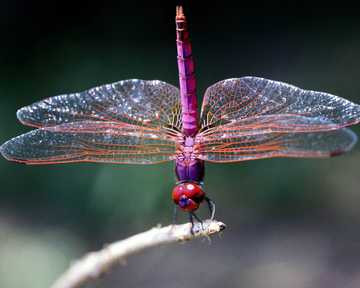
Dragonflies belong to the insect group Odonata. They are divided in
three suborders: the "real" dragonflies or Anisoptera, damselflies or Zygoptera
and a small third suborder, containing only one Japanese and one Nepalese
species, the ancient dragonflies or Anisozygoptera.
Real dragonflies or Anisoptera are larger than damselflies. At rest
they spread their wings alongside their body at a 180 degree angle. The
shape of the forewings is different from that of the hind wings: the hind
wings are wider at the base and have a larger surface (Anisoptera means
"unequal wings"). Their eyes touch on top of their head or the distance
between their eyes is smaller than the width of their eyes.
The Damselfly's body is slimmer and usually shorter than that of dragonflies.
They keep their wings above their back when resting. The hind wings have
the same shape as the forewings (Zygoptera means "equal wings"). The distance
between their eyes is larger than the width of the eyes themselves.
The ancient dragonflies or Anisozygoptera seem to be a combination
of dragon and damselflies: they have a fierce, heavy body and eyes that
touch, but keep their Zygopteran shaped wings above their back when resting.
There are nearly 2500 different species of dragonflies.
Dragonflies are among the most ancient of living creatures. Fossils
show that the insects were flying more than 300 million years ago, predating
dinosaurs by over 100 million years and birds by some 150 million.
Dragonflies can be found around freshwater ponds, lakes and streams
in most parts of the world.
Dragonfly adults have a pair of prominent compound eyes that take up
most of the head, a thorax,three pairs of legs, two pairs of large, delicate,
membranous wings, and a long, slender abdomen.
Dragonflies breathe through spiracles (holes) in the abdomen. During
their earlier, larval, stage, the insects live in water and breathe through
gills. During both stages, Dragonflies exhibit voracious appetites, feeding
exclusively on small animal matter.
In most cases a female dragonfly deposits her eggs on a plant stem
below water level. Some females make slits in the stem above water level
and deposits the eggs into the slits.
Starting out life as small nymphs underwater, they grow to be approximately
three inches long, with a wingspan averaging two to five inches in width.
Dragonflies will spend only a very short part of their life span as
actual dragonflies. They will live as nymphs for up to four years, shedding
their skin up to fifteen times, yet when they finally mature into adults
they will survive only a few months.
Dragonflies come in varied colors; their bodies often blue, green,
purple, and even bronze.
In most species, males are more brightly coloured than females.
Each leg of the Dragonfly is covered with short bristles. They use
their bristle-covered legs to form an oval shaped basket that allows them
to scoop insects, such as mosquitoes, right out of the air.
Dragonflies not only eat mosquitoes; they also keep the fly population
and other flying insects under control.
Dragonflies can fly in excess of forty miles and hour!
When it gets hot some dragonflies point their long abdomens right at
the sun. This way the sun's rays only hit the tip of the abdomen and not
the whole length, keeping the dragonfly much cooler.
Dragonflies do not sting nor can they harm humans in any other way.
text from http://www.angelfire.com/me4/dalebeesbugs/Adragonfly.html